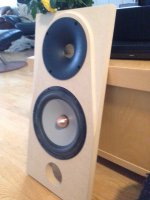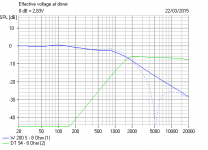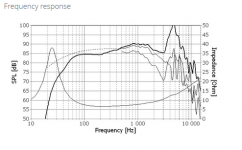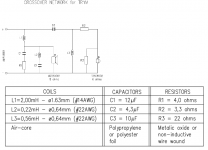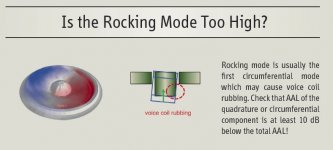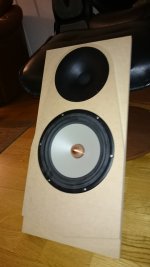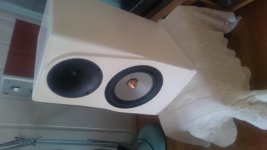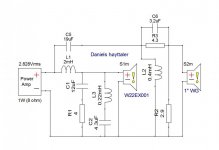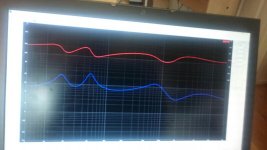So you thought this was a slip of the pen ?
Something new, something stolen, something borrowed, something's ****** up?
TRIM is the heritage of TRYM (the indigenous) .
Wave Guide is directly stolen from Zaphs TMM.
Can such a bastard perform any sweet tunes?
Why do we see a shade of (not 50 grey..not pale) a Duette on the test baffle?
Another wannabe?
Something new, something stolen, something borrowed, something's ****** up?
TRIM is the heritage of TRYM (the indigenous) .
Wave Guide is directly stolen from Zaphs TMM.
Can such a bastard perform any sweet tunes?
Why do we see a shade of (not 50 grey..not pale) a Duette on the test baffle?
Another wannabe?
Attachments
Yup, that looks like it might work! 🙂
TRYM
Below, roughly, electrical response with and without the 5kHz bass notch.
Waveguide tweeter will be different, of course.
TRYM
Below, roughly, electrical response with and without the 5kHz bass notch.
Waveguide tweeter will be different, of course.
Attachments
Sound promising System 7.
I just got some measurement systems from PartsExpress (Omnimic & DATS V2) to measure drivers in cabinet, releasing my buddies from headace ;-)
I altered the baffle layout: Port is now at the rear of cabinet. A compact cabinet for 2-way may leak some inside information (i.e.midrange) thru the port.
I just got some measurement systems from PartsExpress (Omnimic & DATS V2) to measure drivers in cabinet, releasing my buddies from headace ;-)
I altered the baffle layout: Port is now at the rear of cabinet. A compact cabinet for 2-way may leak some inside information (i.e.midrange) thru the port.
I believe the theory of helmholtz resonators, also known as Reflex, says the tube goes on the front. You just try to keep the midrange leakage down with a bit of carpet or similar behind the tube. It doesn't sound bad anyway.
Anyway, SEAS have done the bass filter and cabinet geometry right, I'm sure. I'd use the TRYM 27cm wide box unchanged, if it was me. It's quite nice how symettrically placed the woofer is too. I think that discourages rocking modes.
I've a feeling the TRYM design is going to be a bit bass heavy though, with that 2mH coil.
Anyway, SEAS have done the bass filter and cabinet geometry right, I'm sure. I'd use the TRYM 27cm wide box unchanged, if it was me. It's quite nice how symettrically placed the woofer is too. I think that discourages rocking modes.
I've a feeling the TRYM design is going to be a bit bass heavy though, with that 2mH coil.
Attachments
Is the waveguide gain to be handled?"As delivered". Measurements under 200 should be ignored (early reflections).
Sounds refreshingly open and detailed.
I'm not sure if I understand your question.
The WG is pretty the same as in Zaphs TMM.
I did struggle a bit to get the assembly sounding seamless.
A diy "colleague" reports that the Seos-8 WG is preferable after having tested both.
The WG is pretty the same as in Zaphs TMM.
I did struggle a bit to get the assembly sounding seamless.
A diy "colleague" reports that the Seos-8 WG is preferable after having tested both.
The frequency response shown seems to show a waveguide gain of about 8dB and so I was asking about it (not that I know quite what the plot is showing).I'm not sure if I understand your question.
The WG is pretty the same as in Zaphs TMM.
How come you aren't reshaping the tweeter response back to flat? Looks like you still have a 5-10dB tilt down from 3k to 20k. That's kind of the point of using a waveguide - you gain up the 1-5kHz region so once you reshape that region back down to flat non-linear distortion goes way down and you have more or less the same (flat) frequency response you started off with.
I got some transitions challenges at the xo-point with this 8" - and a stright /flat response do sound too bright (subjectively). Anyway, we are pretty happy with the result.
Ideas for improvements are, of course, most welcome.
Ideas for improvements are, of course, most welcome.
That is odd because with a flat on axis response a waveguide with a narrower beam width will have less high frequencies in the reflections and avoid the steep change from narrow midwoofer to wide tweeter of a 2 way with a flat baffle.I got some transitions challenges at the xo-point with this 8" - and a stright /flat response do sound too bright (subjectively). Anyway, we are pretty happy with the result.
Ideas for improvements are, of course, most welcome.
Is the measurement shown an in room response, a response close to the speakers, a response at the listening position and off-axis, a sweep, white noise, gated or not, etc... All these will change the frequency response with some ideally flat and others ideally sloping down.
You have potentially a nice speaker there but the crossover is going to be challenging to get right. The driver has a massive resonance around 4.5kHz dictating a notch, a crossover frequency ideally below 1.5 kHz and steep slopes to avoid exciting it either directly or with significant motor harmonics when playing at decent levels of SPL. The waveguide gain should help push the workable tweeter crossover frequency lower which is useful but it will still be tight. 8" metal 2 ways are not easy to get right which is why they are relatively rare.
I wonder if the brightness might be exciting the woofer resonance? Does it become more unpleasant at higher SPLs?
Sorry, the speakers are far away right now. The woofer were quite deep down in the 4-5 k area, not very different from the Trym.
What crossover frequency? What slope? Have you implemented a notch?Sorry, the speakers are far away right now. The woofer were quite deep down in the 4-5 k area, not very different from the Trym.
The Trym crossover is described: "The crossover network is conventional except for a parallel cicuit which supresses the response peak due to the magnesium cone. The crossover frequency is 1.6kHz." Is this what you have done?
How do you know the response of your speaker is similar to the Trym response? Have you seen plots of the Trym woofer and tweeter responses and a distortion plot at 96 dB which would help address concerns about how well the resonance is controlled. Compared to the later SEAS DIY designs this is conspicuous by its absence for the Trym.
From my XO-dwg you will see that the woofer section is identical to Trym.
The WG section is matched by measurement. The slope towards 20 khz is adjusted by capacitor C6. Measurement distance apporox 3m. ( I do not like flat tuning). A smaller cap will strighten out the curve. Regarding the 4,5hz breakup,- this may be realized by higher SPLs ? It's absent by "normal" volumes, also for the original Trym.
The WG section is matched by measurement. The slope towards 20 khz is adjusted by capacitor C6. Measurement distance apporox 3m. ( I do not like flat tuning). A smaller cap will strighten out the curve. Regarding the 4,5hz breakup,- this may be realized by higher SPLs ? It's absent by "normal" volumes, also for the original Trym.
There is more than one way of exciting the resonance:Regarding the 4,5hz breakup,- this may be realized by higher SPLs ? It's absent by "normal" volumes, also for the original Trym.
1) The obvious one is by a low level 4-5kHz signal sent to the woofer. Since it is a +20dB peak and you want to push it down to, say, -50dB (the target figure is debatable) that means a signal of -70dB in this region. A conventional crossover for softer damped cones will get nowhere near this level hence the move towards lower crossover frequency, steeper slopes and a notch.
2) A less obvious one is via the 3rd harmonic distortion of the driver at 1.5kHz. The woofer signal level is close to maximum here, say, -3dB. If the 3rd harmonic is at -40dB the +20dB peak will mean the resonance is -23dB below the tweeter output at 4.5kHz and hence audible. Now the level of 3rd harmonic depends on the quality of the motor (good in your case) and the deflection of the cone. As you raise the SPL the 3rd harmonic distortion will increase making the resonance more audible. You can control this to some extent by lowering the crossover frequency and increasing the slope. Unfortunately the small tweeter is being pushed against its low frequency limit leading to high distortion at higher SPLs.
Here is an example of a decent attempt to get an 8" metal woofer 2 way to work. It involved cherry picking the tweeter for low frequency response, 8th order slopes, a notch and a 1.4kHz crossover frequency (lower in the Mk 1). What you are trying to do is not easy and I have some doubts (but no evidence) about how well the resonance is controlled in the the Trym design. Measurements would be interesting as well as your subjective impression with a conventional frequency response.
A most interesting example, thank you. A kind of NTM-crossover?
I will also look back to the TMM-project crossover that don't posess any bright sound.
I will also look back to the TMM-project crossover that don't posess any bright sound.
- Status
- Not open for further replies.
- Home
- Loudspeakers
- Multi-Way
- Seas TRIM (W22EX001 + WG)
